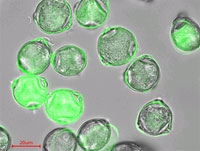The hidden danger of oxygen
23 Feb 2011
New findings from researchers at the Max Planck Institute for Chemistry and the Paul Scherrer Institute in Switzerland help to explain how toxic and allergy-causing substances in our air are formed. The scientists have for the first time detected long lived reactive oxygen intermediates on the surface of aerosol particles.
 |
| Birch pollen with allergenic potential. The colouring of the fluorescence microscopic picture shows © Christoher Pöhlker/MPI for Chemistry |
These forms of oxygen survive here for more than 100 seconds and in that time react with other air pollutants such as nitrogen oxides. Chemically speaking, the dust particles are oxidised and nitrated. This is what makes soot particles more toxic and increases the potential of pollen to cause allergies.
Although scientists have suspected for years that these intermediate forms exist, it was believed that they disappeared within a fraction of a second, and therefore had little impact on chemical processes in the atmosphere. The intermediate forms of oxygen develop when ozone reacts with particulate matter such as soot, polycyclic aromatic hydrocarbons or pollen proteins.
"Not only does our research resolve earlier contradictions between theoretical calculations and measurements, it also shows that intermediates are also responsible for many atmospheric and physiological reactions," said Manabu Shiraiwa, lead author of the study.
Ulrich Pöschl, head of the aerosol research group at the Max Planck Institute in Mainz, goes one step further: "We suspect that the increase in allergies in industrialized countries is linked to these reactions. The more ozone and nitrogen oxides that are emitted by industry and traffic, the more frequently organic molecules such as birch pollen proteins are being nitrated and this is what irritates our immune system.'' Pöschl and his colleagues have obtained evidence that these nitrated proteins can indeed cause more severe allergic reactions than the native protein form. If this hypothesis is confirmed, human health would be at even greater risk from combustion-related emissions than previously thought.
The reactive oxygen intermediates may also explain some of the direct adverse health effects of diesel soot and tobacco smoke particles. The polycyclic aromatic hydrocarbons found on the surface of these particles again readily react with ozone and form long-lived reactive oxygen intermediates. If the particles are inhaled, they interact directly with physiological processes in the human lung and other organs.






.webp)

















